http://vigilantcitizen.com/moviesandtv/labyrinth-starrin
The 1986 movie Labyrinth, starring David Bowie and Jennifer Connelly, immerses the viewers into a world of fantasy and wonder. Like many other fantastic tales, the movie conceals within its symbolism an underlying meaning and, in this case, it is rather disturbing. Labyrinth describes the programming of a mind control victim at the hands of a sadistic handler. We will look at the occult meaning of the symbolism found in Labyrinth.
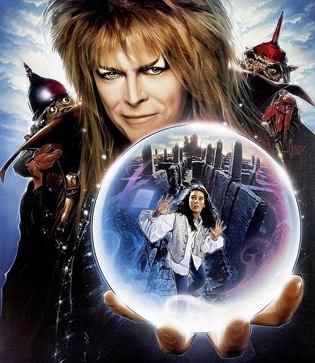
Labyrinth is a quintessential 80s movie that contains everything we love from the 80s: 80s synth music, 80s CGI effects and a 80s David Bowie in the same 80s hairdo that your aunt Susan had in the 80s. What’s not to love? The movie has, in fact, become a “cult classic” and is still a children’s favorite.
But like many of these delightfully twisted fantasy movies, there is more to Labyrinth than meets the eye. By understanding the occult symbolism and references in Labyrinth, the movie becomes a big allegory for mind control, where each scene refers to a particular aspect of the process. What appears to be a young girl’s quest through a Labyrinth to find her baby brother becomes a metaphor for the internal world of a mind control victim that is being programmed by a handler. The obstacles that Sarah, the hero of the story, must go through relate to real life ordeals inflicted to mind control slaves to incite dissociation (if you have no idea what I’m talking about, read the article entitled Origins and Techniques of Monarch Mind Control). Mind games, torture, drugs and sexual abuse are all referred to in veiled symbolism during the movie, giving to “those in the know” an entirely different story than what is shown at face value. Labyrinth is therefore constructed like most esoteric works in History: it uses symbolism to conceal from the masses while revealing to the initiates.
Very little prior knowledge is required to understand the underlying meaning of Labyrinth. however. The movie was, in fact, mentioned by a few authors on mind control who described it as one of the most blatant movies on Monarch programming. Fritz Springmeier even states Labyrinth is used by actual mind control handlers as a programming script to train the slaves. This very plausible as the movie bears many similarities to Alice in Wonderland and Wizard of Oz – two movies that are known to be used in mind control programming. The only difference is that Labyrinth was probably specifically constructed to this purpose while, at the same time, exposing the masses to this kind of symbolism.
Since Labyrinth is a blueprint for mind control, it is only fitting that the star of the show is an artist who has served as a blueprint to modern pop stars: David Bowie. Throughout his long and eclectic career, Bowie has touched on many occult and ritualistic themes that are today rehashed by industry-made pop stars. And, for some reason, many of those who touch upon these occult themes also integrate mind control into their works. Maybe it is due to the fact that mind control heavily relies on black magic rituals and Kabbalistic teachings. So, before we look at the symbolism of the movie, let’s take a brief look at some of the symbolism used by David Bowie.
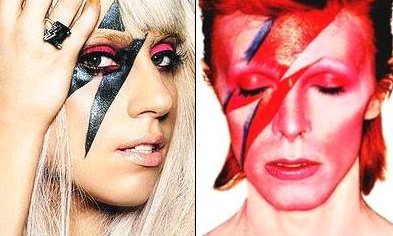


The difference between Bowie and today’s pop stars is that he was
rather open regarding the occult influence in his act and music. In a
1995 interview, Bowie stated: “My overriding interest was in cabbala
and Crowleyism. That whole dark and rather fearsome never-world of the
wrong side of the brain.” In his 1971 song Quicksand, Bowie sang:
Since the main antagonist of Labyrinth is a sorcerer who also happens to enjoy singing impromptu pop songs, David Bowie was a perfect fit for the role. Did he know that he played the role of a mind control handler?
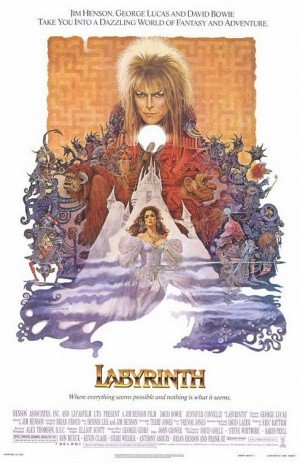
Released in 1986, Labyrinth was a collaborative effort
between George Lucas, Jim Henson (his last movie) and David Bowie. Using
state-of-the-art effects, the movie quickly became a classic in what we
can call the “twisted fantasy” genre. The plot of the movie is simple: A
teenage girl named Sarah goes through a strange, magical Labyrinth to
recover her baby brother who was kidnapped by a sorcerer named Jareth
and his army of goblins.
Some critics did not appreciate the random nature of the events of the movie. Robert Ebert stated that these kind of movies “aren’t as suspenseful as they should be because they don’t have to follow any logic. Anything can happen, nothing needs to happen, nothing is as it seems and the rules keep changing.” By describing the movie this way, Ebert unknowingly describes the inner-world of a mind control slave, which is exactly what the Labyrinth represents. Through trauma, the psyche of the slave is reprogrammed by the handler resulting in a situation where anything can happen, nothing needs to happen, nothing is as it seems and the rules keep changing.
Sarah’s quest for her baby brother is, in fact, a quest to recover her innocent core persona (her “real” self) that was taken by the handler. The various events that happen to Sarah are distorted reflections of real mind control trauma – hidden behind a veil of fantasy and imagination.
Labyrinth is heavily symbolic from beginning to end, starting from the very first scene. Sarah is at a park, dressed as a princess, practising lines to a play under the watchful eye of an owl that is standing on top of an obelisk.
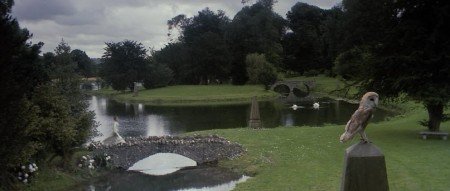
We quickly learn that the owl is Jareth, the goblin King (played by
David Bowie). The fact that Jareth takes the form of an owl in the “real
world” and that he sits at the top of an obelisk is very telling about
what he actually represents: The occult elite. The owl is known to be
the main symbol of the Bavarian Illuminati and is still used by elite
groups such as the Bohemian Grove. It represents “those who act under
the cloak of darkness”.
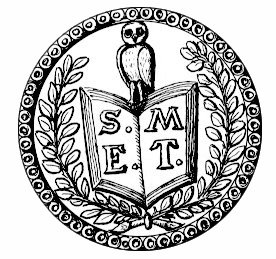
The owl is at top of an obelisk, a monument that is constantly
visible throughout the entire movie. The obelisk has been, for
centuries, the ultimate symbol of power of the occult elite. It is found
standing at the world’s most powerful places and strange occult powers
are attributed to them. These tall monuments originate from the ancient
Egypt and are said to represent the lost phallus of Osiris – in other
words, male energy. The obelisk is therefore a phallic symbol and the
fact that this young girl encounters many of them during her quest might
be a reminder of the male handler dominating her mentally and sexually
(through abuse).
The owl watches Sarah, who is dressed as a princess and practising a role for a play, illustrating her natural tendency to dissociate from reality and to take on other personalities, a characteristic that MK handlers seek when scouting for potential slaves. Sarah is therefore “marked” by the shady Illuminati Mind Control system.
At Sarah’s house, we find several clues relating to her predisposition to mind control. She is surrounded by toys, books and posters that foretell the dissociative adventure she is about to embark in. Many of Sarah’s toys will be found animated during her adventure, which tells us that everything that will happen will be a result of her own imagination, fuelled by the things that are familiar to her.
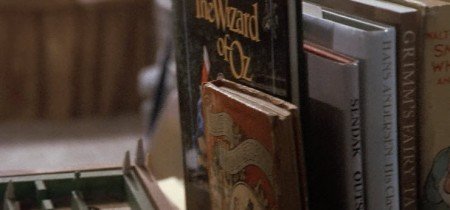
Right above Sarah’s bed is Escher’s famous drawing named “Relativity”.
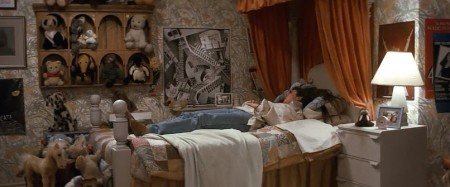
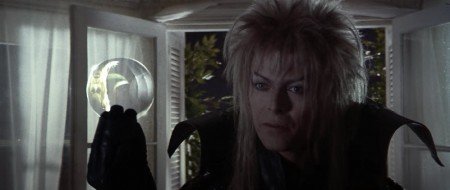
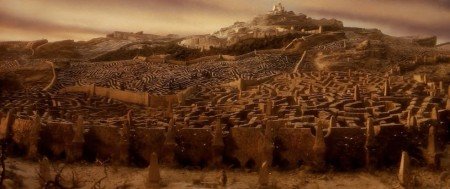

Sarah then learns that it is only by mentally picturing an entry
towards the castle that one will appear. She must make her own path
within her own mind.
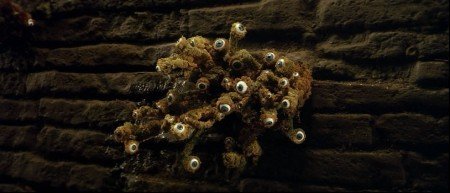
While trying to advance through the Labyrinth, Sarah realizes that
everything keeps changing around her. She meets strange creatures who
say confusing riddles that lead to never-ending loops of circular logic.
Her catchphrase appears to be “It’s not fair” as she repeats it
numerous time during the movie. This phrase does sum up pretty nicely
the life of a MK slave. There are no rules and every kind of unfairness
can occur.
Meanwhile, Jareth is in the castle with Toby, monitoring Sarah.
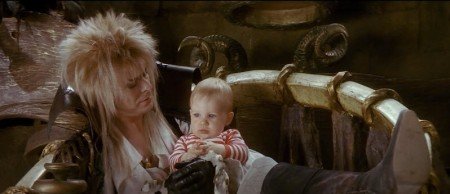
In Sarah’s first ordeal, she falls into a pit filled with “helping hands”.
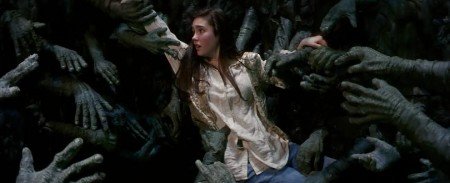
Later, Sarah finds herself in a forest and surrounded by the Fire
Gang, who are strange singing creatures that can remove parts of their
bodies at will. The concept of dismembered body parts is central to mind
control programming.
The Fire Gang’s performance soon turns into a nightmare when they jump on Sarah and try to remove her head.
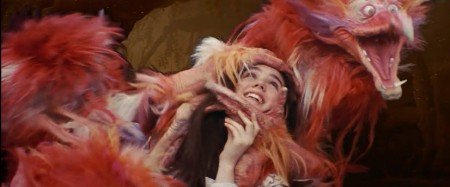
Upon escaping the Fire Gang, Sarah finds herself in an even worst place, the Pool of Eternal Stench.

Sarah and her friends are forced to go through the nauseating pond in
order to continue the quest. This odd scene can refer to the actual
mind control technique to induce trauma which consists in immersing the
slaves in feces and urine and/or to consume them. Our natural repulsion
to excrements and the foul odor we get from them are our body’s way to
tell us to stay away from them because they are infested with all kinds
of worms and parasites that are toxic to us. Our organisms are so well
made that we are instinctively repulsed by the things that are bad for
us. The forced consumption of excrements is therefore particularly
traumatic as it goes against the human body’s most basic instincts.
Sarah’s episode in the Pool of Eternal Stench is a “imaginative” way to
describe Sarah’s traumatic experience as a MK slave during programming.
After crossing the pool, Sarah is given a gift – one that is poisoned of course.

When Sarah takes a bite from the peach, she feels woozy and starts
hallucinating. Monarch slaves are constantly given drugs to amplify the
effects of the programming and to incite fear and terror. Laying on the
ground, Sarah sees a crystal ball with a symbolic image representing
her.

Sarah is then shown at a strange ball with guest wearing masks of
goats, pigs and birds (commonly called an Illuminati ball) and finds
Jareth, her handler, waiting for her.
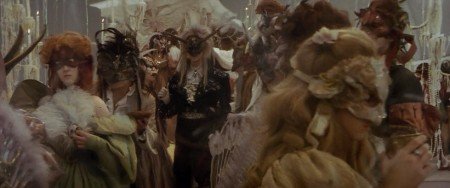
Jareth and Sarah find each other and begin waltzing together, with
Jareth giving suggestive looks … to a 15-year-old girl. The scene
symbolically portrays the forced Satanic union between the slave (who is
said to be the princess of her world) and her handler. The lyrics of
David Bowie’s song playing during the ball can be interpretative as a
“love song” from a handler to a mind control slave.
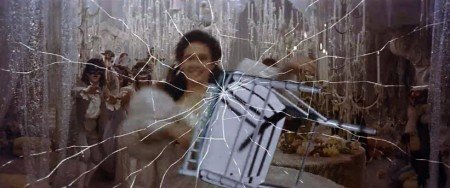
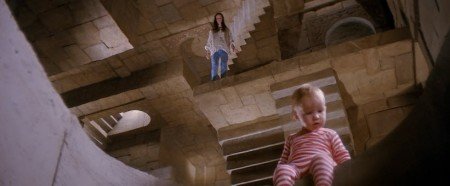
Then the entire world around Sarah crumbles, leaving only her facing
her handler. Sarah asks Jareth to give her back the baby (her innocent
core). Jareth gives her a classic double-speak, mind-bending lecture –
the kind MK slaves get from their handlers. He says:

He says:
Sarah then starts reciting the lines she was practising at the beginning of the movie and says “You have no power over me”. Everything crumbles again, Sarah leaves her internal world and finds herself back in the external world, the real world, her house. Toby is back in his crib and everything is apparently back to normal.
In her room, sees some of the creatures she has met in the Labyrinth and is apparently happy to see them. She tells them:
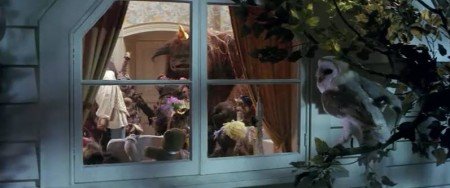
The movie closes with David Bowie’s song “Underground”. The song has
very church-y feel (with a loud a gospel choir accompanying him) and
talks about a place with “no pain”. That place is not heaven, but
“Underground”, which can be equated to hell, which, in mind-control
terms, is the trauma-filled life of a MK slave.
So, in perfect continuation with the movie, Bowie leaves the viewers with one last inversion of good and evil, heaven and hell and pleasure and pain, with this song:
g-david-bowie-a-blueprint-to-mind-control/
“Labyrinth” Starring David Bowie: A Blueprint to Mind Control
By VC | November 4th, 2011 | Category: Movies and TV | 241 commentsThe 1986 movie Labyrinth, starring David Bowie and Jennifer Connelly, immerses the viewers into a world of fantasy and wonder. Like many other fantastic tales, the movie conceals within its symbolism an underlying meaning and, in this case, it is rather disturbing. Labyrinth describes the programming of a mind control victim at the hands of a sadistic handler. We will look at the occult meaning of the symbolism found in Labyrinth.

Labyrinth is a quintessential 80s movie that contains everything we love from the 80s: 80s synth music, 80s CGI effects and a 80s David Bowie in the same 80s hairdo that your aunt Susan had in the 80s. What’s not to love? The movie has, in fact, become a “cult classic” and is still a children’s favorite.
But like many of these delightfully twisted fantasy movies, there is more to Labyrinth than meets the eye. By understanding the occult symbolism and references in Labyrinth, the movie becomes a big allegory for mind control, where each scene refers to a particular aspect of the process. What appears to be a young girl’s quest through a Labyrinth to find her baby brother becomes a metaphor for the internal world of a mind control victim that is being programmed by a handler. The obstacles that Sarah, the hero of the story, must go through relate to real life ordeals inflicted to mind control slaves to incite dissociation (if you have no idea what I’m talking about, read the article entitled Origins and Techniques of Monarch Mind Control). Mind games, torture, drugs and sexual abuse are all referred to in veiled symbolism during the movie, giving to “those in the know” an entirely different story than what is shown at face value. Labyrinth is therefore constructed like most esoteric works in History: it uses symbolism to conceal from the masses while revealing to the initiates.
Very little prior knowledge is required to understand the underlying meaning of Labyrinth. however. The movie was, in fact, mentioned by a few authors on mind control who described it as one of the most blatant movies on Monarch programming. Fritz Springmeier even states Labyrinth is used by actual mind control handlers as a programming script to train the slaves. This very plausible as the movie bears many similarities to Alice in Wonderland and Wizard of Oz – two movies that are known to be used in mind control programming. The only difference is that Labyrinth was probably specifically constructed to this purpose while, at the same time, exposing the masses to this kind of symbolism.
Since Labyrinth is a blueprint for mind control, it is only fitting that the star of the show is an artist who has served as a blueprint to modern pop stars: David Bowie. Throughout his long and eclectic career, Bowie has touched on many occult and ritualistic themes that are today rehashed by industry-made pop stars. And, for some reason, many of those who touch upon these occult themes also integrate mind control into their works. Maybe it is due to the fact that mind control heavily relies on black magic rituals and Kabbalistic teachings. So, before we look at the symbolism of the movie, let’s take a brief look at some of the symbolism used by David Bowie.
David Bowie: The One They All Imitated
Many articles on
this site mention modern pop stars and the occult symbolism embedded in
their works. It was only a matter of time before David Bowie was
mentioned as he is apparently a major source of inspiration for many of
them. David Bowie is indeed the prototype of the pop-star/occult icon
whose works incorporated concepts originating from Secret Societies.
From strange alter-egos, to the occult concept of androgyny, and of
course including references to Aleister Crowley and his Thelema, Bowie
did decades ago what pop stars are doing now.

"Bowie's
alter-ego named Ziggy Stardust was a representation of the "illuminated
man" who has reached the highest level of initiation: androgyny. There
was also a lot of one-eye things going on.

Drawing the Kabbalistic Tree of Life

Bowie dressed in Egyptian garbs (like Crowley used to do) and displaying the hand sign of "as above so below"
“I’m closer to the Golden Dawn(Golden Dawn is the name of a Secret Society that had Crowley as member). These are only some examples of the occult influence on Bowie’s work and an entire book could be written on the subject.
Immersed in Crowley’s uniform of imagery”
Since the main antagonist of Labyrinth is a sorcerer who also happens to enjoy singing impromptu pop songs, David Bowie was a perfect fit for the role. Did he know that he played the role of a mind control handler?
Labyrinth

This poster of the movie Labyrinth is full of MK trigger images.
Some critics did not appreciate the random nature of the events of the movie. Robert Ebert stated that these kind of movies “aren’t as suspenseful as they should be because they don’t have to follow any logic. Anything can happen, nothing needs to happen, nothing is as it seems and the rules keep changing.” By describing the movie this way, Ebert unknowingly describes the inner-world of a mind control slave, which is exactly what the Labyrinth represents. Through trauma, the psyche of the slave is reprogrammed by the handler resulting in a situation where anything can happen, nothing needs to happen, nothing is as it seems and the rules keep changing.
Sarah’s quest for her baby brother is, in fact, a quest to recover her innocent core persona (her “real” self) that was taken by the handler. The various events that happen to Sarah are distorted reflections of real mind control trauma – hidden behind a veil of fantasy and imagination.
The Premise
The plot of the movie is very reminiscent of the Wizard of Oz and Alice in Wonderland, two stories that are incidentally known to be used in mind control programming. A young girl, bored and distraught with her normal life, finds herself in a fantasy land, where everything can happen. In order to go back home, she embarks on a dangerous quest to reach a great castle (not unlike the Emerald city of the Wizard of Oz). Along the way, the assertive girl uses her wits, courage and strength to go past the obstacles in a world where no rules are established.Labyrinth is heavily symbolic from beginning to end, starting from the very first scene. Sarah is at a park, dressed as a princess, practising lines to a play under the watchful eye of an owl that is standing on top of an obelisk.

An owl is standing at the top of an obelisk, watching over Sarah.

Symbol of the Minerval Church of the Bavarian Illuminati featuring a watchful owl.
The owl watches Sarah, who is dressed as a princess and practising a role for a play, illustrating her natural tendency to dissociate from reality and to take on other personalities, a characteristic that MK handlers seek when scouting for potential slaves. Sarah is therefore “marked” by the shady Illuminati Mind Control system.
At Sarah’s house, we find several clues relating to her predisposition to mind control. She is surrounded by toys, books and posters that foretell the dissociative adventure she is about to embark in. Many of Sarah’s toys will be found animated during her adventure, which tells us that everything that will happen will be a result of her own imagination, fuelled by the things that are familiar to her.

Among
Sarah's stuff we find a toy version of the obelisk-studded labyrinth
she is about to enter and the books of Wizard of Oz and Alice in
Wonderland. Both of these fairy tales are used to encourage victims to
dissociate from reality. Labyrinth is no different and is probably used
in actual mind control programming.

Escher's "Relativity" (the image with the stairs going in all directions) right above Sarah's bed.
Escher’s mind-boggling images contain
confusing features that the mind can never compute. For this reason,
they are used in actual mind-control programming. This particular
painting will become very important later in the movie.
“If [the child] has artistic brainwaves, then the programmer will use art work in programming. The art work of the european artist M.C. Escher is exceptionally well suited for programming purposes. For instance, in his 1947 drawing “Another World”, the rear plane in the center serves as a wall in relation to the horizon, a floor in connection with the view through the top opening and a ceiling in regards to the view up towards the starry sky. Reversals, mirror images, illusion, and many other qualities appear in Escher’s art work which make all 76 or more of his major works excellent for programming.”
- Fritz Springmeier, The Illuminati Formula to Create a Mind Control Slave
So Sarah is angry at her parents,
especially her step-mother, because she has to stay at home and babysit
her little brother named Toby while they go out. Confronted with the
child’s incessant cries, Sarah wishes for the Goblin King to take him
away. An owl then enters the room and turns itself into Jareth, the
Goblin King.

Jareth offering Sarah "gifts" represented by the crystal ball
Jareth has taken Toby to his world and
will turn him into one of his goblins. In mind control terms, baby Toby
represents Sarah’s core personality that was taken away by Jareth, her
handler. As long as Jareth holds Sarah’s core persona, he will be able
to make her go through the Labyrinth – which will represent her
programming.
When Sarah asks to Jareth to hand back
Toby, the Goblin King uses his skills for manipulation and persuasion.
He shows Sarah a crystal ball and tells her that it contains “all of her
dreams”. He however warns that is is “not a gift for an for an ordinary
girl who takes care of a screaming baby”. In other words, the gift is
only for girls who have lost the baby – victims of mind control. Jareth
the handler has the power to help Sarah escape the life she loathes but
she must allow him to own her core personality – to control her mind.
When Sarah refuses Jareth’s offer, which is equivalent to the Faustian
theme of selling one’s soul to the Devil, the crystal ball magically
turns into a snake and is thrown at her. Jareth then menacingly says:
“Don’t defy me”. Seeing that she will not forget about the baby, Jareth
tells Sarah that Toby is at his castle and that she has 13 hours to find
him. They are both transported into the Labyrinth, which is a big image
representing Sarah’s inner-world under the control of a handler.
Inside the Labyrinth

Sarah
must traverse a gigantic Labyrinth in order to reach the castle, which
represents her walled-off and compartmentalized core persona. The entire
labyrinth is Sarah's inner-world and Jareth is the undisputed master of
everything that happens in it. He can also change everything at will.
Obelisks are found all across the Labyrinth, a phallic symbol reminding
of the sexual control the handlers have over their slaves.
Inside the Labyrinth, Sarah quickly
realizes that it does not obey the rules of reality. She finds herself
walking never-ending straight paths leading to nowhere.

The Labyrinth appears to be an infinite straight path to nowhere.

Strange
plants with eyes on the walls of the Labyrinth reminds us that Sarah is
tightly monitored by her handler during the entire process. The symbol
of the all-seeing eye is heavily used in actual mind control
programming.
Meanwhile, Jareth is in the castle with Toby, monitoring Sarah.

Jareth on his horned throne.
The Ordeals
In her path towards the castle, Sarah goes through all kinds of obstacles, many of which symbolically represent actual traumas lived by mind control victims.In Sarah’s first ordeal, she falls into a pit filled with “helping hands”.

Sarah
is held and grabbed by countless hands around her. This can refer to
the victims being manipulated and abused by hidden handlers.
The Fire Gang’s performance soon turns into a nightmare when they jump on Sarah and try to remove her head.

The Fire Gang trying to remove Sarah's head from her body, representing the MK slave's dissociation from reality.

The
Pool of Eternal Stench is basically a big gassy pond full of feces. It
keeps emitting flatulence and belches and is therefore very "bodily"
place.
After crossing the pool, Sarah is given a gift – one that is poisoned of course.

Sarah
receives a peach that makes her hallucinate - a thinly veiled allusion
to the drugs that are given to Monarch slaves during programming.

Sarah sees doll in princess clothes surrounded by bars - a classic way to portray dissociative mind control slaves.

Jareth waiting for Sarah behind a horned masked at the Illuminati ball.
“As the pain sweeps throughThe ball then quickly turns into a nightmare, where all of the masked guests start running after her (is she “bad-tripping”?). Sarah starts running, shatters a mirror and runs through it, another classic symbol of mind control.
Makes no sense for you
Every thrill has gone
Wasn’t too much fun at all
But I’ll be there for you
As the world falls down …
… It’s falling down”

To escape the ball, Sarah must shatter a mirror - a symbolic image representing the fracture of her personality.
Confronting Jareth
Despite all of those troubles, Sarah finally reaches the castle and enters it. She finds herself lost in a life-size Escher painting with Toby crawling. Jareth magically appears from everywhere in the scene, the same way handlers appear in the inner-world of Monarch slaves.
Sarah in a life-size Escher image
“I have reordered time … I have turned the world upside down … I have done it all for you. I am exhausted from living up to your expectations of me. Isn’t that generous?”He then offers her the crystal ball again.

"Jareth asks Sarah to sell her soul in exchange of her dreams
“Look what I’m offering you. Your dreams. I ask for so little. Just let me rule you, and you can have everything that you want. Just fear me, love me, do as I say, and I will be your slave”.This is the classic Faustian “deal with the Devil” proposal, where Jareth says that he “asks for so little” while he is actually asking for Sarah’s everything: Her mind, body and soul.
Sarah then starts reciting the lines she was practising at the beginning of the movie and says “You have no power over me”. Everything crumbles again, Sarah leaves her internal world and finds herself back in the external world, the real world, her house. Toby is back in his crib and everything is apparently back to normal.
In her room, sees some of the creatures she has met in the Labyrinth and is apparently happy to see them. She tells them:
“I don’t know why, but … every now and again in my life, for no reason at all, I need you.”In other words, Sarah has accepted the internal world that was programmed into her by her handler. It now can be triggered by him at any time during her life.

Sarah
and her friends party in her room under the watchful eye of an owl,
Jareth, who has never lost control of her. He is actually the winner of
the duel with Sarah. Her programming is complete.
So, in perfect continuation with the movie, Bowie leaves the viewers with one last inversion of good and evil, heaven and hell and pleasure and pain, with this song:
“No one can blame youWhile most viewers interpret the story of Labyrinth as a tale about “the importance of imagination” or something of the sorts, the symbolism of the movie gives it a deeper meaning. While the story could be interpreted in numerous ways (another article could be written about Sarah’s quest being a metaphor for esoteric initiation) references to mind control are definitely present. Once the imagery and the triggers relating to mind control are understood, the movie becomes a vivid description of the internal world of a Monarch slave during programming. Totally at the mercy of her handler and the twisted world he created in her mind, the slave attempts to return to reality, where things make sense. The task is difficult as the handler controls time (hence the 13-hour clock that keeps popping up during the movie) and space (secret passages in the Labyrinth). During the quest, the slave meets friends who appear to be helping her, but who are, in actuality, leading her to exactly where her handler wants her to be. In fact, Sarah’s entire “quest for liberation” is actually her being manipulated towards the acceptance of her programming. By going through the Labyrinth, Sarah went through all of the trauma necessary to program her. What appears to be the defeat of Jareth is actually a victory as he successfully programmed Sarah’s internal world. It can be used, in her words “every now and again in her life”.
For walking away
Too much rejection (na na)
No love injection
Life can be easy
It’s not always swell
Don’t tell me truth hurts, little girl
‘Cause it hurts like hell
But down in the underground
You’ll find someone true
Down in the underground
A land serene
A crystal moon, ah, ah
It’s only forever
Not long at all
Lost and lonely
That’s underground
Underground
Daddy, daddy, get me out of here
Ha ha I’m underground
Heard about a place today
Nothing ever hurts again
Daddy, daddy, get me out of here
Ah ha I’m underground
Sister sister, please take me down
Ah ah I’m underground
Daddy, daddy, get me out of here“
In Conclusion
Like Wizard of Oz and Alice in Wonderland, Labyrinth is an imaginative fairy tale whose story can be used as a programming script in mind control programming. Unlike the older tales however, Labyrinth might have been specifically constructed for mind control purposes. The story, the symbolism and the music of the movie all form a cohesive sensory-overload, where the viewers are totally immersed in the strange world of mind control. There is however one hitch: like mind-control victims, most viewers are completely duped by the movie and its message. While it appears to be about the triumph of a girl’s mind over evil, its is actually the triumph of evil over a girl’s mind. In the words of Bowie, Don’t tell me truth hurts, little girl, ‘Cause it hurts like hell.g-david-bowie-a-blueprint-to-mind-control/



No comments:
Post a Comment